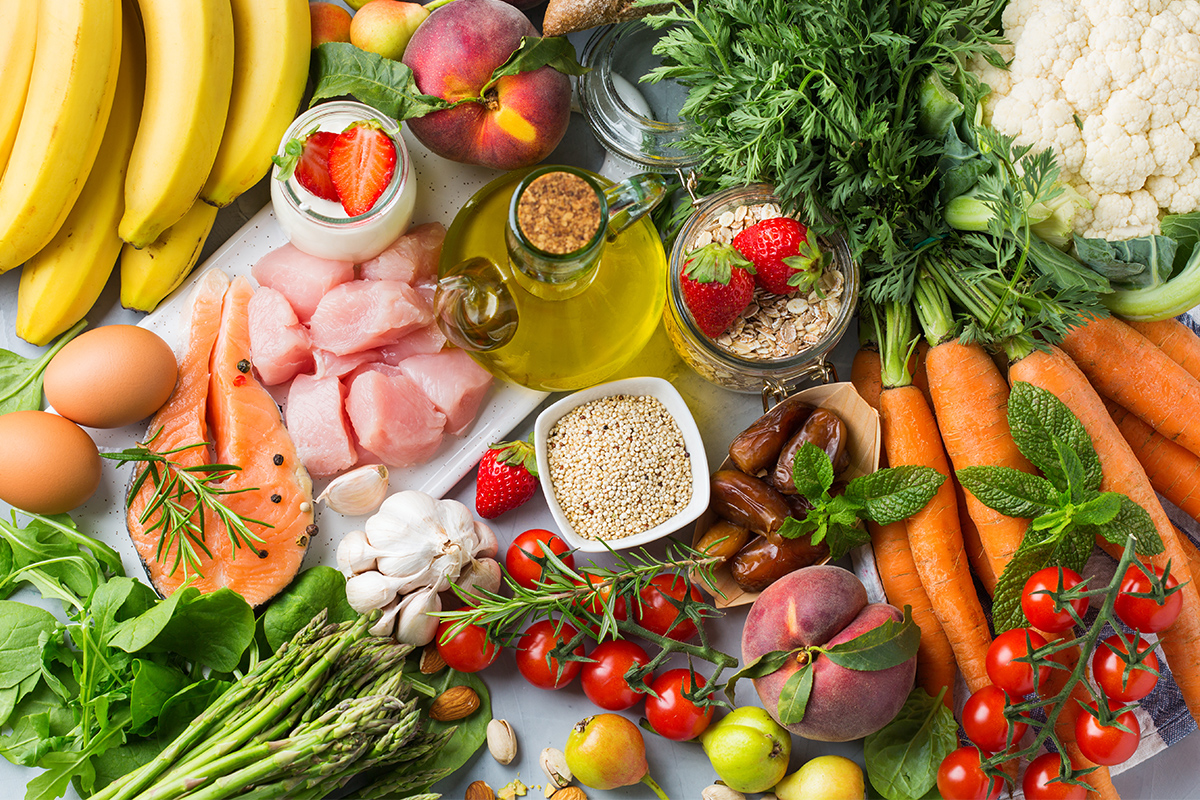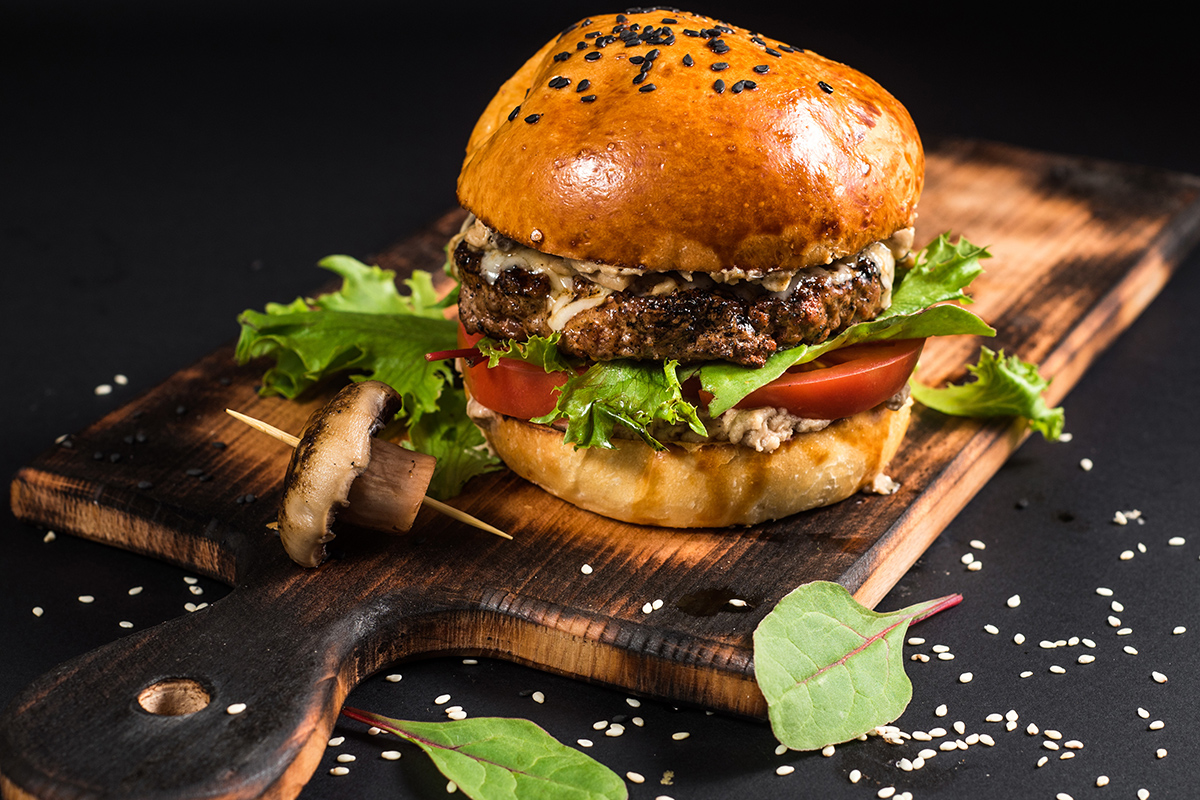Nutritious Green Foods You Didn’t Know About
Good nutrition is all about variety! Browse through our list of unusual fruits and veggies and give yourself a chance to try something new.


My husband and I are thinking about having a baby, what is a good nutrition guide to follow when pregnant?
-Misty

How wonderful! Why not follow a smart pre-conception diet now? Laying down a good nutritional foundation means that you’ll not only increase the likelihood of conceiving but also of a healthy first trimester – for you as well as the baby. Get hubby on board, too. ?
Many “conception diets” recommend that half your plate be from fruits and vegetables, a quarter from whole grains and a quarter lean protein, which agrees with USDA’s Choose MyPlate guidelines. If you’re trying to get pregnant, drinking reduced or whole fat milk is correlated with normal fertility, but not 1% or skim (non-fat). Consume healthy plant-based fats like avocado, nuts, olives and coconut oil in moderation. Limit refined sugar, red meat and foods containing trans-fat.
As many women don’t know they are carrying a baby until several weeks into pregnancy, taking a prenatal vitamin with 100% RDI of folic acid (400 µg folate equivalent) and iron (18 mg) is advisable. Many produce items (notably spinach, asparagus, Brussel sprouts) have the B-vitamin folate, necessary for early neural tube development. Dietary sources of the important blood mineral iron include meat, fortified cereals, beans, and dark green leafy vegetables.
During pregnancy, follow your obstetrician’s advice and that from established and trusted institutions such as The American College of Obstetricians and Gynecologists (ACOG), The Academy of Nutrition and Dietetics (AND), and The US Office on Women’s Health (OWH).
You’ll need extra fluids, nutrients and calories as your pregnancy progresses. In the first trimester, folate and other vitamins and minerals are crucial for proper neural tube development, so a good prenatal vitamin is key. Strictly avoid alcohol during this time.
The second trimester is when you start to expand blood volume and increase maternal stores while your baby grows rapidly from the size of a nut (3”, 1 oz.) to a football (12”, 1 lb.) while developing all of its organs and features. About 2 additional cups of fluids are needed per day. Adding around 300 extra calories from healthy foods with adequate calcium and iron will support this growth.
In the last trimester, your baby is filling out to full-term weight. This is when you are truly “eating for two, ” although in terms of energy, you really only need an additional 200 calories on top of your 2nd trimester needs.
Sources:
– Debbie J., MS, RD
This article should not replace any exercise program or restrictions, any dietary supplements or restrictions, or any other medical recommendations from your primary care physician. Before starting any exercise program or diet, make sure it is approved by your doctor.
Some questions have been edited for length and/or clarity.
 Have a nutrition question? Our registered dietitian is ready to help!
Have a nutrition question? Our registered dietitian is ready to help!
Email nutrition@lafitness.com or submit your question below and it may be featured in an upcoming article!
Good nutrition is all about variety! Browse through our list of unusual fruits and veggies and give yourself a chance to try something new.
Does liberally salting your food help you pump more iron in the gym? Registered Dietitian, Debbie James, investigates the claims!
One frequently asked question is about the recommended intake of protein. We hear you! Here is everything you need to know.


Hi, my name is Nigel and I was wondering if you could help me with eating tips for someone trying to clean bulk. Thanks.
– Nigel A.

As a dietitian I interpret your inquiry as you’d like advice for bulking up on strictly a ‘clean’ diet. Bulking up without gaining fat pretty much means eating a clean diet, anyway.
Clean foods – those that are raw or minimally processed – include energy dense foods like avocados, banana, coconut, fatty fish, meats, nuts, extra virgin olive oil, poultry dark meat, seed butters, and soybeans which can help you put on weight. Muscle weight if resistance training consistently, of course. Starchy vegetables like corn, potatoes, peas and winter squash and (naturally) dried fruit provide more energy per bite than watery ones. Other higher calorie foods (by weight) such as granola/trail mix, pesto and cottage cheese can be made from scratch if raw/unprocessed is desired. Incorporating eggs and quinoa helps to keep protein intake up.
Resources:
– Debbie J., MS, RD
This article should not replace any exercise program or restrictions, any dietary supplements or restrictions, or any other medical recommendations from your primary care physician. Before starting any exercise program or diet, make sure it is approved by your doctor.
Some questions have been edited for length and/or clarity.
 Have a nutrition question? Our registered dietitian is ready to help!
Have a nutrition question? Our registered dietitian is ready to help!
Email nutrition@lafitness.com or submit your question below and it may be featured in an upcoming article!
Good nutrition is all about variety! Browse through our list of unusual fruits and veggies and give yourself a chance to try something new.
Does liberally salting your food help you pump more iron in the gym? Registered Dietitian, Debbie James, investigates the claims!
One frequently asked question is about the recommended intake of protein. We hear you! Here is everything you need to know.

Meatless burgers that bleed and have the taste and mouthfeel of cooked ground beef are here to stay! Whether from restaurants or the grocery store, these next generation meat analog products are seemingly everywhere. Curious or health-conscious carnivores are happy to gobble down mock meat foods in an attempt to reduce their risk of cancer or heart disease while many vegetarians embrace the convenience of these prepared plant products. Now there are even blended patties combining beef with plant proteins to please every omnivore and flexitarian.
| Did you know? The first commercially available veggie patty was from an English “VegeBurger” mix in 1982, according to www.Smithsonian.com. |
Beef is from nature and beans are from nature… But highly processed foodstuffs made from either of them aren’t as healthy and definitely aren’t considered natural. Fresh, lean red meat offers high-quality protein, is rich in niacin, selenium, zinc, and vitamins B6 and B12, and is a good source of potassium. Unfortunately, the way typical Americans prepare ground beef – exposed to high heat until charred – creates compounds harmful to health1. With the newer meat analogs, there’s a concern over preservatives, sodium, additives like smoke flavor, artificial colors, and other factory-derived proprietary ingredients2.
Sure, we can pick them apart individually* and talk about isolated ingredients, but it may be wise to focus on the bigger picture of one’s overall diet first3. Health agencies and experts most often recommend a varied diet rich in antioxidants and vegetables, moderate in fat, with adequate micronutrients, protein and fiber1. So, it makes a difference if these newer veggie burgers replace meat or take the place of raw plant foods, and how often they do so.
There’s a growing body of research supporting the risks of red meat consumption1 and the health benefits of replacing animal proteins with plant proteins4. Compared to pure ground beef patties, plant-based burgers are naturally devoid of cholesterol and vitamin B12, may be lower in saturated fat, are higher in fiber, but are also higher in sodium3. Compared with traditional DIY veggie patty recipes that call for minimal ingredients (beans, grains, vegetables, and mushrooms), they’re lower in fiber and are higher in sodium.
One of the major differences between the current next generation plant patties and other processed legume-based burgers (such as Morningstar Farm® Grillers) is in their appearance and texture to replicate the experience of eating meat. You can thank a few choice ingredients for the aroma, flavor and look of meat-like patties.

A side-by-side nutritional comparison showed that Impossible Burger, Beyond Burger™, and 85% lean real beef have similar protein content (19-21 grams per 4 ounces)5. Soy and pea protein are the primary protein contributors in the new analogs, making them higher in protein than veggie burgers which never contained beans (such as Gardenburger® Original).
Still, they differ from legumes in traditional bean-based burgers (e.g. BOCA burger, Dr. Praeger’s® Heirloom Bean) in that they are refined — and that’s not such a bad thing. Digestion of isolated proteins is slightly greater than whole plant food protein4 while the digestibility score of soy protein is about 97%, one of the highest for plant proteins. Isolating the protein from beans leaves out the natural factors that inhibit protein digestion4, so for the newer meatless patties there could be greater protein digestibility than from traditional whole bean burgers.

A compound synthetically derived from methyl chloride treatment of cellulose, a plant cell structural component, it is used as a thickening and/or gelling agent in processed foods and as a natural laxative. As a high-viscosity fiber, some studies show methylcellulose may help blunt blood sugar response to a meal6 and relieve constipation.

A convincing meaty appearance often comes from the addition of beets which impart a vibrant color, mimicking the juiciness of beef. Omnivores and cross-over carnivores see the ‘bleed’ as a positive burger characteristic, just as most people expect grill marks on a patty. Beets offer not only color, but a sweet, earthy flavor and nutrients such as folate, manganese, potassium plus the antioxidant betaine.

Plant burgers with legume heme as a color additive may also sizzle and smell like real meat4. Legume hemoglobin (called legume heme for short) is a plant-derived oxygen carrier similar to blood hemoglobin and has a distinct red color which releases upon heating5.

It contains both mono and polyunsaturated fats, vitamin E, and cholesterol lowering phytosterols5. Sounds good but some studies have shown that it releases hazardous aldehydes when it’s used in high-heat cooking, such as frying5.
Overall, the newer meatless burgers provide a needed cross over for people wanting to incorporate more healthy plant-based foods by replacing the all-American favorite beef hamburger. For omnivores, these mock meats allow a seamless transition in the burger category. However, those already eating a (mainly) plant only diet may be better served by sticking to whole food ingredients for their health unless they have issues obtaining sufficient protein.
* Numerous meatless burger products abound – too many to mention. Inclusion of or exclusion of any particular brand name does not imply recommendation against or endorsement for that brand’s product(s). Products mentioned are for consumer reference and comparison only.


What is the best type of recovery drink that can help my muscles recover quicker from exercising?
– David A.

The optimum content of your recovery drink depends on the type of exercise, intensity and duration.
Stop by your club’s juice bar to see what’s likely to fit into your recovery nutrition. No matter what you choose, remember to consider portion/energy since some shakes can contain over 300 calories and may surpass what was burned during the exercise!
– Debbie J., MS, RD
This article should not replace any exercise program or restrictions, any dietary supplements or restrictions, or any other medical recommendations from your primary care physician. Before starting any exercise program or diet, make sure it is approved by your doctor.
Some questions have been edited for length and/or clarity.
 Have a nutrition question? Our registered dietitian is ready to help!
Have a nutrition question? Our registered dietitian is ready to help!
Email nutrition@lafitness.com or submit your question below and it may be featured in an upcoming article!
Good nutrition is all about variety! Browse through our list of unusual fruits and veggies and give yourself a chance to try something new.
Does liberally salting your food help you pump more iron in the gym? Registered Dietitian, Debbie James, investigates the claims!
One frequently asked question is about the recommended intake of protein. We hear you! Here is everything you need to know.

The big game calls for big snacks with some equally big numbers on their nutrition label. We all allow ourselves a little room for our favorite foods sometimes, and major events usually take credit for this. However, there’s no need to forfeit your goals if you’ve strayed from the path.
There is a way to recover from your splurge, and it’s not a crash diet. Here are 5 healthy ways to get yourself back on track:

Food cravings are natural and there are a lot of reasons for them. Often, they are linked to common physical and emotional triggers like a lack of sleep, PMS, stress, nutrient deficiencies, and more.1 So, even if your cheat day wasn’t game day, it’s good to understand that our bodies often fight with our brains when it comes to cravings.
The good news? There is evidence to indicate that the occasional cheat day can help you stay on track for long-term goals.1 True, the excess calories or getting kicked out of ketosis can make your progress slow-going, but, having an outlet to occasionally enjoy your guilty pleasures can make the mental battle a bit more bearable.
The other tips come in no particular order but it’s a good idea to check-in with yourself first to make sure you’re not beating yourself up for the cheat. It’s healthy to acknowledge that cheat days are a good thing in moderation, and if you really overdid it, that you are capable of making a comeback.

Water helps your body do what it’s already doing, better. Drink water to help your liver and kidneys do what they do best, which is to help process and flush out toxins.2 It’ll also benefit your digestive tract and help move things along. If you ate something your body was no longer accustomed to receiving, you may start to feel a little “backed up.” Water will help get things back to normal.
In addition to helping your bodily processes, drinking water can help you eat less. Cheat days usually involve sugar and carbs, the food items most people are cutting from their daily diets. Sugar and carbs do a great job of lighting up your craving for more! Chances are, the day after your cheat day, you’ll be craving just a few more nibbles. Drinking water can help you feel more satiated which helps fight additional cravings.

You might be tempted to weigh yourself to assess the damage but doing so will not help you at all. The scale will almost certainly tell you that you’ve gained weight. Seeing a higher-than-normal number can be really discouraging, but the good news is that the weight you gained is not fat. It takes much longer to gain fat than you might think. The extra weight is most likely water.3
Here’s the thing: carbohydrates are a good source of glycogen, an easy-to-process energy source. Glycogen happens to bond very well with water,3 a readily available molecule in your body. This is why the scale says you are heavier, because for every gram of carbohydrates, you have 3 or 4 molecules of water bonded to it.3 Your body retains this water and the scale reflects the added weight. Keep your sanity by staying off the scale and take comfort in the fact that you can still bounce back from water-weight.
You might think, “well, #2 was to drink water; won’t that add to water-weight?” It really won’t. Drinking water is actually cited as a method to help lose water weight.4 When your body feels dehydrated, it will cling to the water it has. Conversely, if you over-hydrate, your body will retain water as well. Just keep a balance.

Speaking of glycogen, if your body has some fresh stores, use them! When you eat carbs, your body breaks them down into glucose. That glucose is either used up for immediate energy or converted into glycogen and saved for later.5 Your body has limited glycogen storage and unlimited fat storage, so if your glycogen stores get full, your body converts glycogen into triglycerides (a type of fat). Triglycerides can be used for energy or get stored in your body fat.5
Get a solid workout in to help use up the stored energy and limit your carb intake to help your body use what you put in on your cheat day.

Make sure your cheat day doesn’t turn into a cheat week. Remember that a single day or meal isn’t going to undo weeks or months of hard work, that the scale is most likely reflecting water-weight, and that you can help your body get back to healthy habits. Look back fondly on how delicious your cheat meal was and then zero back in on healthy eating.
For information on how train your taste buds to love the taste of health foods, read our article: It’s an Acquired Taste. If you’re still thinking about how the body uses glycogen and when it starts burning fat, read our article about Exercising on an Empty Stomach.
To stay informed with our fitness and nutrition articles, subscribe to our newsletter to receive monthly highlights from the LA Fitness blog!
Be the first to know about exclusive
content, deals and promotions